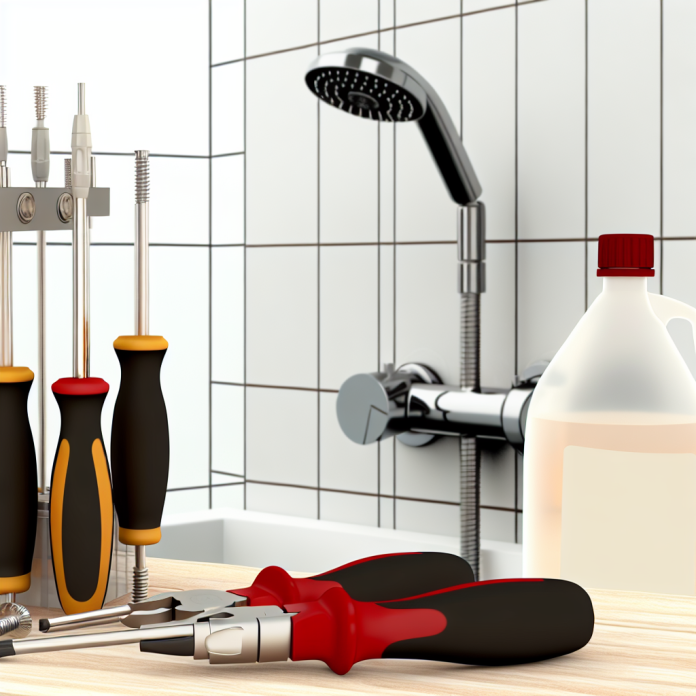If you’re facing difficulties with your shower diverter and need prompt shower diverter repair, you’re not alone! This essential component directs water flow from your bathtub faucet to the showerhead, making it crucial for a satisfying shower experience. When things go awry, such as water pouring from both the tub and showerhead simultaneously, it can lead to frustrating shower diverter issues. Fortunately, understanding how to fix a shower diverter is simpler than many think, and can often be accomplished with a few household items and some guidance. From shower diverter cleaning to potentially shower diverter replacement, this article will arm you with the knowledge you need to tackle your repair efficiently.
When it comes to managing your bathroom plumbing, addressing the malfunction of a water diversion mechanism is essential. Often referred to as a tub spout diverter or shower control valve, this device plays a pivotal role in channeling water as needed. Should you find yourself dealing with stubborn diverter complications, knowing how to troubleshoot and implement effective solutions can save you time and stress. From minor adjustments to complete replacements, these steps can ensure proper functionality and enhance your overall bathing experience. Let’s explore the straightforward methods for fixing a shower diverter and restoring control over your water flow!
Understanding Shower Diverter Issues
Many homeowners find themselves battling shower diverter issues, which can disrupt daily routines and lead to frustrating experiences. Common problems including simultaneous water flow from both the bathtub faucet and the showerhead typically indicate malfunctioning diverters. Identifying these issues early can help prevent water wastage and ensure seamless use of your bathing fixtures.
In essence, shower diverter issues often stem from accumulated debris, corrosion, or deteriorated components inside the valve. Regular maintenance and cleaning are crucial to prolonging the life of your diverter. If you notice improper function, the first step is to assess whether it can be easily repaired or if a replacement is necessary.
Tools for Effective Shower Diverter Repair
When engaging in a shower diverter repair, having the right tools at your disposal is essential for successful execution. Some of the key tools include screwdrivers, pliers, a soft brush for cleaning, and a vinegar solution to combat mineral buildup. Ensuring you have these materials can simplify the process and save you time during the repair.
Additionally, having new components such as a shower diverter valve or tub spout on hand can expedite the repair process should you find that cleaning isn’t enough to restore functionality. Make sure to gather everything you need before starting the project to minimize interruptions and enhance efficiency.
Cleaning the Shower Diverter: The First Step to Repair
Cleaning your shower diverter is often the most straightforward method to restore its function. Start by mixing vinegar with equal parts of water to create a powerful cleaning solution. Immerse the diverter in this mixture for several days to effectively break down limescale and grease buildup which could be impeding its operation.
After soaking, scrub the diverter gently with a soft brush to remove any remaining deposits. This cleaning method not only revitalizes the overall functionality of the diverter but also enhances the longevity of the appliance by preventing future malfunctions caused by dirt accumulation.
How to Replace a Shower Diverter Valve
Sometimes, shower diverter cleaning isn’t enough, necessitating a valve replacement. To replace a diverter valve, begin by shutting off the water supply and removing any covers or caps on the diverter. Carefully extract the old valve and make sure to note its specifications to find an exact match for the replacement.
Once the new diverter valve is procured, installation is generally straightforward. Simply reverse the removal process, ensuring all connections are tight and secure. This step is crucial for reducing the risk of leaks that could lead to further issues down the line.
Professional vs. DIY Shower Diverter Repair
When it comes to shower diverter repair, some homeowners opt for professional services, while others prefer a DIY approach. Engaging a plumber may save time and ensure accuracy; however, it typically incurs higher costs. Hiring an expert can also provide peace of mind, especially if you are uncomfortable with plumbing tasks.
Conversely, tackling the issue yourself can save money and empower you with new skills. With a little research and proper tools, most common shower diverter problems can be addressed without professional assistance. It’s important to weigh your comfort levels and experience in DIY repairs before deciding.
Preventative Maintenance for Shower Diverters
Preventative maintenance is vital in ensuring the longevity and efficiency of your shower diverter. Regular cleaning and inspection can thwart common issues, such as water leaks and improper flow. Simple practices, like clearing built-up gunk and minerals, contribute significantly to the smooth operation of the diverter.
Additionally, actively using the diverter can help keep it in good working condition. For example, periodically toggling the diverter can prevent it from getting stuck. These small practices can save you from major repair jobs down the line, preserving your bathroom ecosystem.
FAQ: Common Shower Diverter Questions
Many often wonder how to address a malfunctioning shower diverter. Key questions include how to determine if the diverter requires repair or whether a complete replacement is necessary. The FAQ section of your repair documentation can provide valuable insights regarding common concerns and maintenance tips.
Additionally, you might also read about preventative measures that can keep shower diverters functioning correctly. Understanding the most common issues associated with diverters may also steer you toward necessary repairs or help prevent future problems from accruing.
Final Reflections on Shower Diverter Repair
In conclusion, repair of a shower diverter can be a manageable DIY project or a task best suited for a professional, depending on the severity of the issue and your comfort level. If you find that simple cleanings and minor adjustments do not restore normal function, don’t hesitate to consider replacement options.
Fixing a shower diverter not only improves convenience but can also be a cost-saving measure, as it eliminates the need for hiring professionals. Armed with knowledge and the right tools, anyone can tackle common shower diverter issues with confidence.
The Importance of Knowing Your Diverter Type
Understanding the type of shower diverter you have is critical when it comes to effective repairs and maintenance. There are three main types of diverters: 3-valve, 2-valve, and tee or single-valve diverters. Each comes with its unique mechanism and may require specific approaches to fix or replace.
Knowing your diverter type allows you to gather the correct tools and components ahead of time, making your repair process smoother. Additionally, this knowledge helps in troubleshooting issues adequately, as different types can manifest various symptoms and may need tailored solutions.
Frequently Asked Questions
How to fix a shower diverter that won’t switch water flow?
To fix a shower diverter that won’t switch water flow, start by turning off the water supply and removing the diverter spout. Clean any buildup inside the spout using a vinegar solution to dissolve limescale and debris. If the diverter is still stuck or not sealing properly, consider replacing it with a new valve or spout.
What are common shower diverter issues and how to resolve them?
Common shower diverter issues include water flowing from both the tub and showerhead simultaneously and a stuck diverter. These problems can often be resolved by thoroughly cleaning the diverter and its components with vinegar or replacing faulty parts as necessary.
What methods are effective in shower diverter cleaning?
For effective shower diverter cleaning, create a solution of equal parts vinegar and water, submerge the diverter in this mixture for several hours, and scrub with a soft brush to remove any limescale or debris. This method will help restore proper function without damaging the diverter.
When should I consider shower diverter replacement versus repair?
Consider replacement if your shower diverter is frequently malfunctioning after repairs or cleaning. If internal components are damaged beyond repair, or if you notice persistent leaks even after cleaning, replacing the diverter will ensure long-term functionality.
What tools do I need for fixing a shower diverter?
To fix a shower diverter, you will need a few essential tools: a screwdriver, pliers, sandpaper, vinegar, a soft brush for cleaning, and possibly a new diverter spout or valve if replacement is needed.
How to determine if my shower diverter is damaged?
To determine if your shower diverter is damaged, check for any irregular water flow, such as water still flowing from the tub faucet when the diverter is engaged, or visible signs of wear and build-up that may hinder the diverter’s operation.
What steps are involved in fixing a shower diverter valve?
Fixing a shower diverter valve involves turning off the water supply, removing the spout to access the valve, cleaning any deposits, testing the valve function, and replacing it if cleaning doesn’t resolve the issues.
How do I know what type of shower diverter I have?
You can identify your shower diverter type by looking at the handle mechanism. Common types include 3-valve diverters (for separate hot and cold faucets), 2-valve diverters (for single control), and pull-up/twist diverters on the tub spout itself.
What is the best approach for fixing a stuck shower diverter?
If your shower diverter is stuck, apply a modest amount of lubricant like cooking spray. Wiggle the diverter gently after applying and work it back and forth to loosen any stuck components.
What preventative measures can I take to avoid shower diverter issues?
To prevent shower diverter issues, regularly clean the diverter with vinegar to prevent mineral buildup and use the diverter periodically to ensure it maintains function. Additionally, avoid over-tightening the diverter when closing it to reduce wear.
| Key Point | Description |
|---|---|
| Shower Diverter Definition | A device in the shower valve that directs water from the tub faucet to the showerhead. |
| Common Issues | Water flowing from both tub faucet and showerhead indicates a broken diverter. |
| Types of Diverters | 3-Valve, 2-Valve, and Tee or Single-Valve types. |
| Tools Required | Vinegar, rubber band, screwdriver, plier, duct tape, etc. |
| Repair Steps | Clean, loosen with cooking spray, replace valve if necessary. |
| Maintenance Tips | Activate the diverter intermittently to prevent wear and tear. |
Summary
Shower Diverter Repair can be a simple DIY task if you follow the right steps and have the necessary tools. Addressing diverter issues promptly can prevent water leaks and save you on repair costs. Whether cleaning or replacing parts, being proactive with your shower diverter will enhance your bathing experience significantly.
Source: https://homeyimprovements.com/how-to-fix-a-shower-diverter/
# Transform Your Home: OC Remodeling Opportunities Await
## Why Orange County is the Best Place for Home Renovations
When it comes to home renovations, there’s no better region than Orange County. Homeowners in cities like Laguna Beach, Newport Beach, and Irvine are living in some of California’s most desirable areas, with a median home value of $1.18 million that makes high-value renovations—from $50,000 to $500,000+—a smart financial investment. For OC contractors and remodelers, this translates into a wealth of opportunities to offer bespoke services that cater to the affluent demographics of the area, while enhancing the beauty and functionality of these stunning homes.
## Navigating California’s Building Codes and Permits
For contractors working in Orange County, understanding California’s building codes and the permit process is crucial. Local homeowners often have unique ideas for their remodels, but ensuring that designs adhere to regulations is essential for successful project completion. OC contractors must stay updated on any changes to regulations that could affect their projects, particularly in coastal cities like Huntington Beach where specific zoning laws can impact beachside properties. Knowledge of these codes not only demonstrates professionalism but also builds trust with clients looking to transform their homes seamlessly.
## Climate Considerations in OC Home Remodeling
The charming climate of Orange County is a significant factor when planning renovations. Homes need to be designed with both aesthetics and durability in mind, particularly against the backdrop of occasionally harsh UV rays and ocean air in coastal regions. EC contractors should focus on materials and designs that are not only appealing but also energy-efficient and resistant to the local climate. This not only helps in keeping renovation costs down in the long run but also appeals to environmentally conscious homeowners looking to upgrade their properties.
## Local Suppliers and Resources for Your Next Project
OC contractors have an array of local suppliers and resources at their disposal when executing renovations. From sustainable building materials available through Costa Mesa’s eco-friendly suppliers to cutting-edge design showrooms in Irvine, contractors can access the best products that meet the specific needs of their projects. Partnering with local vendors can strengthen relationships and enhance project outcomes, providing a win-win for contractors and homeowners alike.
## Stand Out in the Competitive OC Market
With the upscale nature of the Orange County market, it’s crucial for remodelers to differentiate themselves. Highlight unique selling points, such as specialty design capabilities or commitment to sustainable practices, to attract OC homeowners looking for high-end results. Providing tailored recommendations that consider both style and functionality will create a positive impression among potential clients.
As the demand for luxurious renovations continues to grow in Orange County, remodeling professionals and contractors are well-positioned to capitalize on this trend. With the right knowledge and resources, transforming homes and making dreams a reality is more than plausible in this thriving market. For homeowners looking to start their renovation journey, now is the perfect time to engage with local professionals and bring those visions to life!


